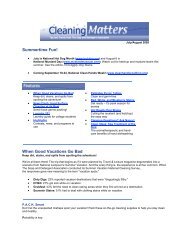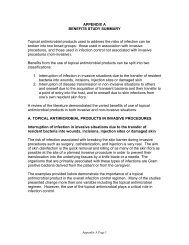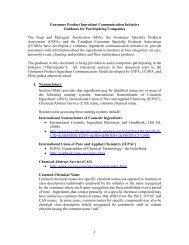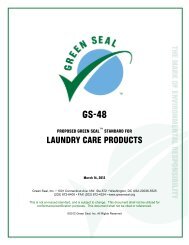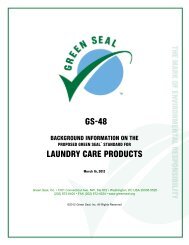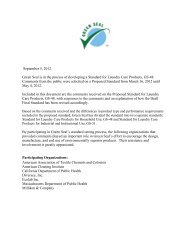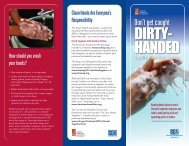subchapter c -- federal hazardous substances act regulations
subchapter c -- federal hazardous substances act regulations
subchapter c -- federal hazardous substances act regulations
You also want an ePaper? Increase the reach of your titles
YUMPU automatically turns print PDFs into web optimized ePapers that Google loves.
30 cycles at a rate of one cycle per two<br />
seconds with a 60-second rest period occurring<br />
after each 10 cycles. Two 120- degree arc<br />
bends shall constitute one cycle.<br />
(e) Torque test — (1) Application — (i)<br />
General. A toy with a projection, part, or<br />
assembly that a child can grasp with at least<br />
the thumb and forefinger or the teeth shall be<br />
subject to this test.<br />
(ii) Toys with rotating components.<br />
Projections, parts, or assemblies that are<br />
rigidly mounted on an accessible rod or shaft<br />
designed to rotate along with the projections,<br />
parts, or assemblies shall be tested with the rod<br />
or shaft clamped to prevent rotation.<br />
(2) Test equipment—(i) Loading device.<br />
The loading device shall be a torque gauge,<br />
torque wrench, or other appropriate device<br />
having an accuracy of ±0.2 inch-pound (±0.23<br />
kilogram-centimeter).<br />
(ii) Clamp. The clamp shall be capable of<br />
holding the test component firmly and<br />
transmitting a torsional force.<br />
(3) Testing procedure. With the toy rigidly<br />
fastened in any reasonable test position, the<br />
clamp is fastened to the test object or<br />
component. A torque of 2 inch-pounds ±0.2<br />
inch-pound (2.30 kilogram- centimeters) shall<br />
be applied evenly within a period of 5 seconds<br />
in a clockwise direction until a rotation of 180<br />
degrees from the original position has been<br />
attained or 2 inch-pounds (2.30 kilogramcentimeters)<br />
exceeded. The torque or<br />
maximum rotation shall be maintained for an<br />
additional 10 seconds. The torque shall then<br />
be removed and the test component permitted<br />
to return to a relaxed condition. This<br />
procedure shall then be repeated in a<br />
counterclockwise direction.<br />
(f) Tension test — (1) Application — (i)<br />
General. Any projection of a toy that the child<br />
can grasp with at least the thumb and<br />
forefinger or the teeth shall be subject to this<br />
test. This test is to be conducted on the same<br />
toy that has been subjected to the torque test<br />
described in paragraph (e) of this section.<br />
(ii) Stuffed toys and beanbags. A stuffed<br />
toy or beanbag constructed of pliable materials<br />
having seams (such as fabrics) shall have the<br />
seams subjected to 10 pounds ±0.5 pound<br />
(4.55 kilograms) of force applied in any<br />
direction.<br />
16 CFR Ch. II (1–1–05 Edition)—proposed modificication – 6/25/06<br />
(2) Test equipment — (i) Clamps. One<br />
clamp capable of applying a tension load to<br />
the test component is required. A second<br />
clamp suitable for applying a tension load<br />
perpendicularly to the major axis of the test<br />
component is also required.<br />
(ii) Loading device. The loading device is<br />
to be a self-indicating gauge or other<br />
appropriate means having an accuracy of ±0.5<br />
pound (±225 grams).<br />
(3) Testing procedure. With the test sample<br />
fastened in a convenient position, an<br />
appropriate clamp shall be attached to the test<br />
object or component. A 10-pound ±0.5 pound<br />
(4.55–kilogram) direct force shall be evenly<br />
applied, within a period of 5 seconds, parallel<br />
to the major axis of the test component and<br />
maintained for an additional 10 seconds. The<br />
tension clamp shall then be removed and a<br />
second clamp appropriate for pulling at 90<br />
degrees shall be attached to the test object or<br />
component. A 10-pound ±0.5 pound (4.55-<br />
kilogram) tensile force shall be evenly applied,<br />
within a period of 5 seconds, perpendicularly<br />
to the major axis of the test component and<br />
maintained for an additional 10 seconds.<br />
(g) Compression test — (1) Application.<br />
Any area on the surface of a toy that is<br />
accessible to a child and inaccessible to flatsurface<br />
cont<strong>act</strong> during the imp<strong>act</strong> test shall be<br />
subject to this test.<br />
(2) Test apparatus. The loading device<br />
shall be a rigid metal disc 1.125 inches ±0.015<br />
inch (2.86 centimeters) in diameter and 0.375<br />
inch (0.95 centimeter) in thickness. The<br />
perimeter of the disc shall be rounded to a<br />
radius of<br />
1 ⁄ 32 inch (0.08 centimeter) to<br />
eliminate irregular edges. The disc shall be<br />
attached to an appropriate compression scale<br />
having an accuracy of ±0.5 pound (±225<br />
grams).<br />
(3) Testing procedure. The disc shall be<br />
positioned so that the cont<strong>act</strong> surface is<br />
parallel to the surface under test. A direct force<br />
of 20 pounds ±0.5 pound (9.1 kilograms) shall<br />
be evenly applied within 5 seconds through the<br />
disc. This load shall be maintained for an<br />
additional 10 seconds. During the test the toy<br />
is to rest on a flat, hard surface in any<br />
convenient position.<br />
-- 59 --



